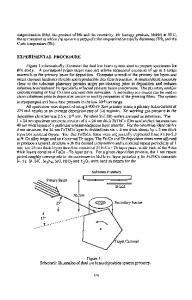Effect of Substrate Strain and Interface on Magnetic Properties of EuTiO 3 Thin Film
- PDF / 1,613,028 Bytes
- 11 Pages / 432 x 648 pts Page_size
- 35 Downloads / 346 Views
Effect of Substrate Strain and Interface on Magnetic Properties of EuTiO3 Thin Film Katsuhisa Tanaka1, Koji Fujita1, Yuya Maruyama1, Yoshiro Kususe1, Hideo Murakami1, Hirofumi Akamatsu2, and Shunsuke Murai1 1 Department of Material Chemistry, Graduate School of Engineering, Kyoto University, Katsura, Nishikyo-ku, Kyoto 615-8510, Japan 2
Department of Materials Science and Engineering, Graduate School of Engineering, Kyoto University, Yoshida-honmachi, Sakyo-ku, Kyoto 606-8501, Japan ABSTRACT Bulk EuTiO3 is known as a compound in which spin and soft phonon mode is strongly coupled. Recent theoretical study suggests that application of stress or formation of strain leads to a drastic change in magnetic and dielectric properties of EuTiO3 and that so-called multiferroic properties emerge under such a situation. In the present study, effect of strain induced by a substrate, on which EuTiO3 thin film is deposited, on the magnetic properties of the film has been experimentally examined. By using a pulsed laser deposition method, EuTiO3 thin film has been deposited on different kinds of substrate, i.e., LaAlO3, SrTiO3, and DyScO3; the lattice parameter of these compounds is smaller than, just the same as, and larger than that of EuTiO3, respectively. X-ray diffraction analysis confirms that the strain induced in the plane of as-deposited EuTiO3 thin films on different substrates is coincident with the lattice parameter of the substrate compounds. Also, all the as-deposited EuTiO3 thin films manifest elongation of lattice in a direction perpendicular to the film surface. Temperature dependence of magnetization indicates that all the thin films exhibit ferromagnetic behavior at low temperatures. The magnetization at 2 K under a magnetic field of 100 Oe is the highest for EuTiO3 on DyScO3 and the lowest for EuTiO3 on LaAlO3. The experimental result is coincident with the first-principles calculations which predict that ferromagnetic spin configuration becomes more stable as the lattice volume of EuTiO3 is increased.
INTRODUCTION The stable phase of EuTiO3 adopts a cubic perovskite structure with a lattice parameter of 0.3905 nm at room temperature and atmospheric pressure. The crystal structure and the lattice parameter are just the same as those of SrTiO3 which has arrested considerable attention recently because of its curious electronic properties. SrTiO3 is quantum paraelectric at low temperatures. Doping of SrTiO3 with La3+ or Nb5+ leads to n-type semiconductor, and in addition, the doped SrTiO3 exhibits superconducting transition, although the critical temperature is below 1 K [1-4]. Recent studies on electronic properties of interface relevant to SrTiO3 disclosed intriguing phenomena. It was found that the interface between SrTiO3 and LaAlO3 generates twodimensional electron gas and leads to superconducting transition at 200 mK although both SrTiO3 and LaAlO3 are insulators [5]. Also, very large thermoelectric Seebeck coefficient was observed for two-dimensional electron gas confined in Nb-doped SrTiO3 quantum well f
Data Loading...











